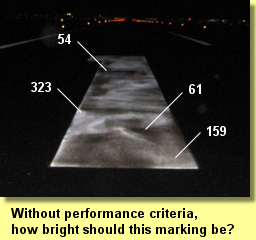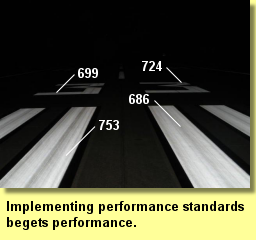 |
 |
Performance AnxietyBy Donna SpeidelSigns, Lights, and Markings make up the three-pronged visual aid system on an airfield serving pilots and airport personnel on the ground. Without them, moving about the airfield safely would be impossible, particularly at night. All three aids have specific governing criteria for position, color, size, orientation, etc. However, while signs and lights have requirements for how bright they must be based on what and where they are on the airfield, airfield markings do not.
Many applicators believe they are complying with specifications by hand-throwing the beads onto the wet paint, or by following the paint application with a fertilizer spreader to distribute the beads. Both methods are generally inadequate for installing a uniform and effective reflective marking. When the FAA mandated that certain markings be reflective, they took a major step towards safer operations. The next major step must be taken, and that is to specify performance-level, quantitative retro-reflectivity values at installation for reflective airifled markings. The precedent has been set with respect to signs and lights - ALL navigational aids should receive the same consideration!
The Airfield Marking Handbook suggests retro-reflective values at installation for the different types of beads on the different colors. Everyone will benefit by including those performance-level values in project specifications. The Handbook is our major source material at the Airfield Marking Symposium, July 11-13 in Boston. Come to learn how your airfield marking program can perform at its highest level. |

 Certain markings are required to be bright (reflective), so they can be seen at night when they are needed most. Yet unlike signs and lights,
there are no specific requirements for how bright airfield markings are supposed to be. In fact, during many of our marking audits, we find that markings
required to be reflective are marginally so, or not at all. We can always tell when the markings were intended to receive glass beads, but the markings
are not effective; they are not doing their job, and it's costing airports dearly.
Certain markings are required to be bright (reflective), so they can be seen at night when they are needed most. Yet unlike signs and lights,
there are no specific requirements for how bright airfield markings are supposed to be. In fact, during many of our marking audits, we find that markings
required to be reflective are marginally so, or not at all. We can always tell when the markings were intended to receive glass beads, but the markings
are not effective; they are not doing their job, and it's costing airports dearly.
 Implementing performance standards for airfield markings will have several associated benefits:
Implementing performance standards for airfield markings will have several associated benefits: